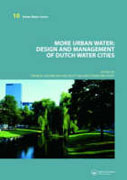
More urban water: design and management of dutch water cities
Hooimeijer, Fransje
Most urban water management systems were developed when precipitation was distributed more evenly throughout the year. High groundwater levels and excess water now result in flooded cellars and inaccessible infrastructure. Future urban water programmes focus on the restructuring and transformation of urban areas, with water management as an integral part of urban renewal activities. Thebook's unique approach deals with the urbanism and water management in Dutch water cities. It treats the financial aspects of adjusting water systems to urban hydrological cycle changes and discusses the city's typology, function andecological and technical aspects. Separate chapters examine historical, inter-war and post-war cities, including comparisons with Seoul, Tokyo, and Ruhr area. INDICE: Chapter 1: Introduction: water's changing context 1.1 Introduction1.2 Climate change 1.3 The Netherlands water land 1.4 The organisation of a water management authority 1.5 Giving space instead of holding water back 1.6 Institutional policy frameworks 1.7 Urban water management 1.8 Expanding the water storage capacity 1.9 Approach on a spatial level 1.10 Costs and sources offunding Chapter 2: The form and function of water in the city 2.1 Introduction 2.2 Basic types of water town 2.3 The expansion of water towns 2.4 The overture to the city 2.5 Expansions in the polder in the interwar years 2.6 Water towns after the war 2.7 The primordial Dutch talent 2.8 The future: Rotterdam Water City 2035 Govert Geldof Chapter 3: The urban design issues in existing cities 3.1 Introduction 3.2 The state of affairs in the prewar city 3.3 The structure of the prewar city 3.4 The issues in the prewar city by theme 3.5 The issue in the prewar city 3.6 The state of affairs in the post-war city 3.7 The post-war urban expansion 3.8 The common approach in the post-war city 3.9 New opportunities in restructuring the post-war city Chapter 4: The water issues inthe existing city 4.1 Introduction 4.2 Water flows 4.3 Guiding principles: comprehensive and sustainable 4.4 Guiding models 4.5 Water issues in the planning process Chapter 5: More water in the historic city centre: transformation 5.1 Introduction 5.2 Catharijnesingel, Utrecht 5.3 Old Harbour, Breda 5.4 East city centre, Delft 5.5 Conclusion Chapter 6: More water in the city, from 1850 to 1945: consolidation 6.1 Introduction 6.2 Museumpark, Rotterdam 6.3 Vogelwijk, The Hague 6.4 Conclusion Chapter 7: More water in the post-war city: restructuring 7.1 Introduction 7.2 Poptahof, Delft 7.3 Wielwijk, Dordrecht 7.4 Schalkwijk, Haarlem 7.5 Conclusion Chapter 8: International comparison 8.1 Introduction 8.2 Seoul (South Korea) 8.3 Tokyo (Japan) 8.4 The Ruhr (Germany) Chapter 9: Conclusions Bibliography
- ISBN: 978-0-415-45358-5
- Editorial: Routledge
- Encuadernacion: Rústica
- Páginas: 150
- Fecha Publicación: 01/06/2008
- Nº Volúmenes: 1
- Idioma: Inglés
